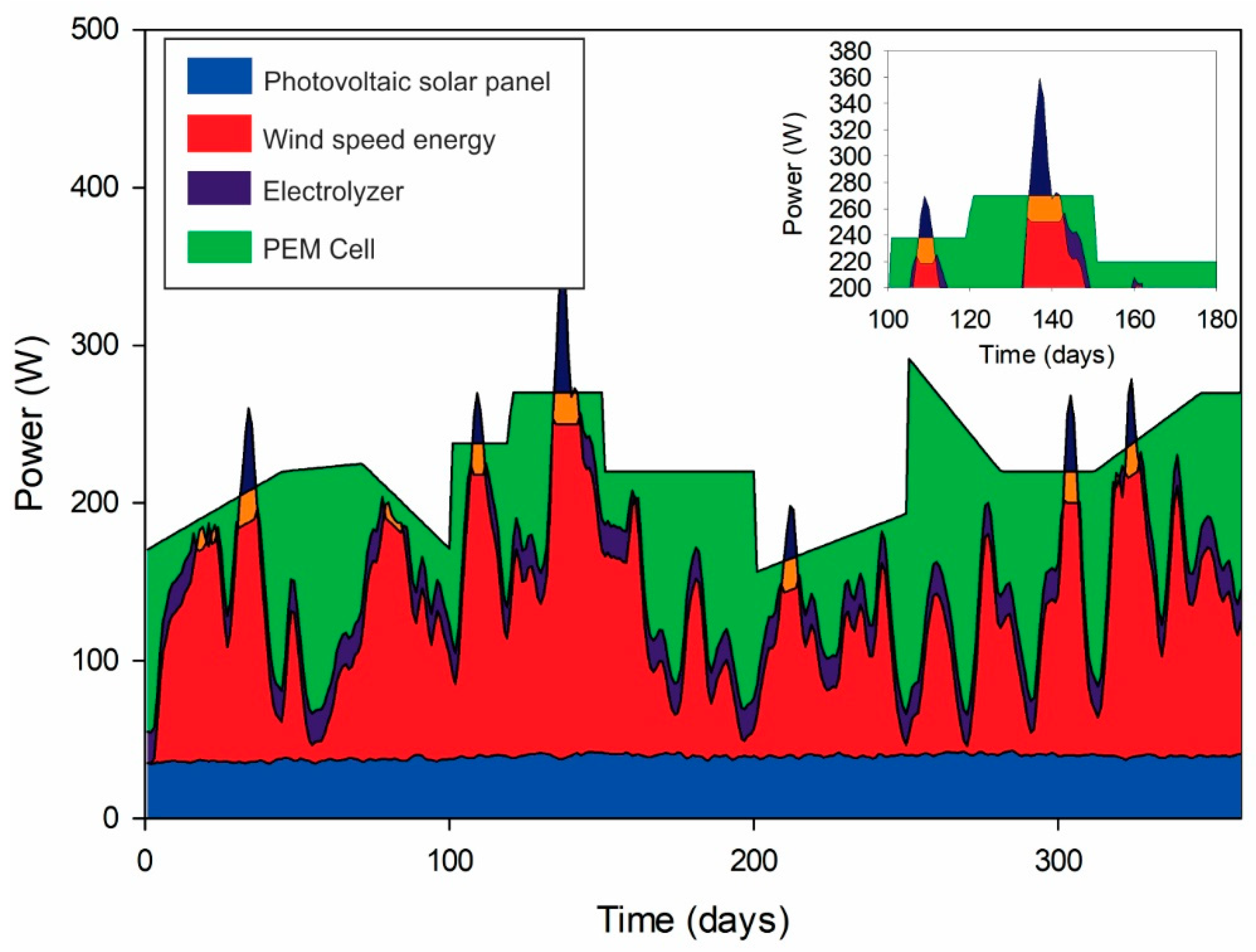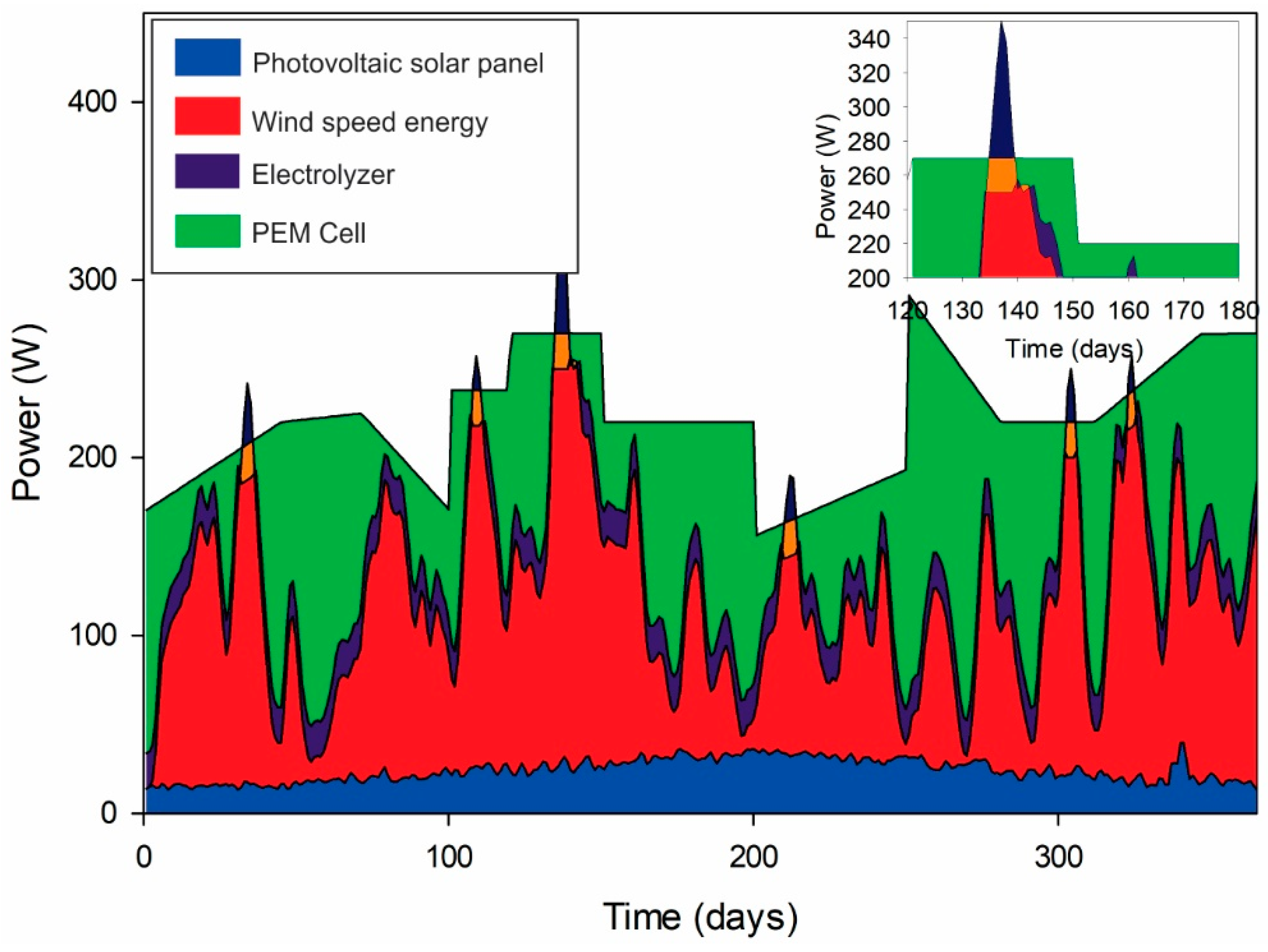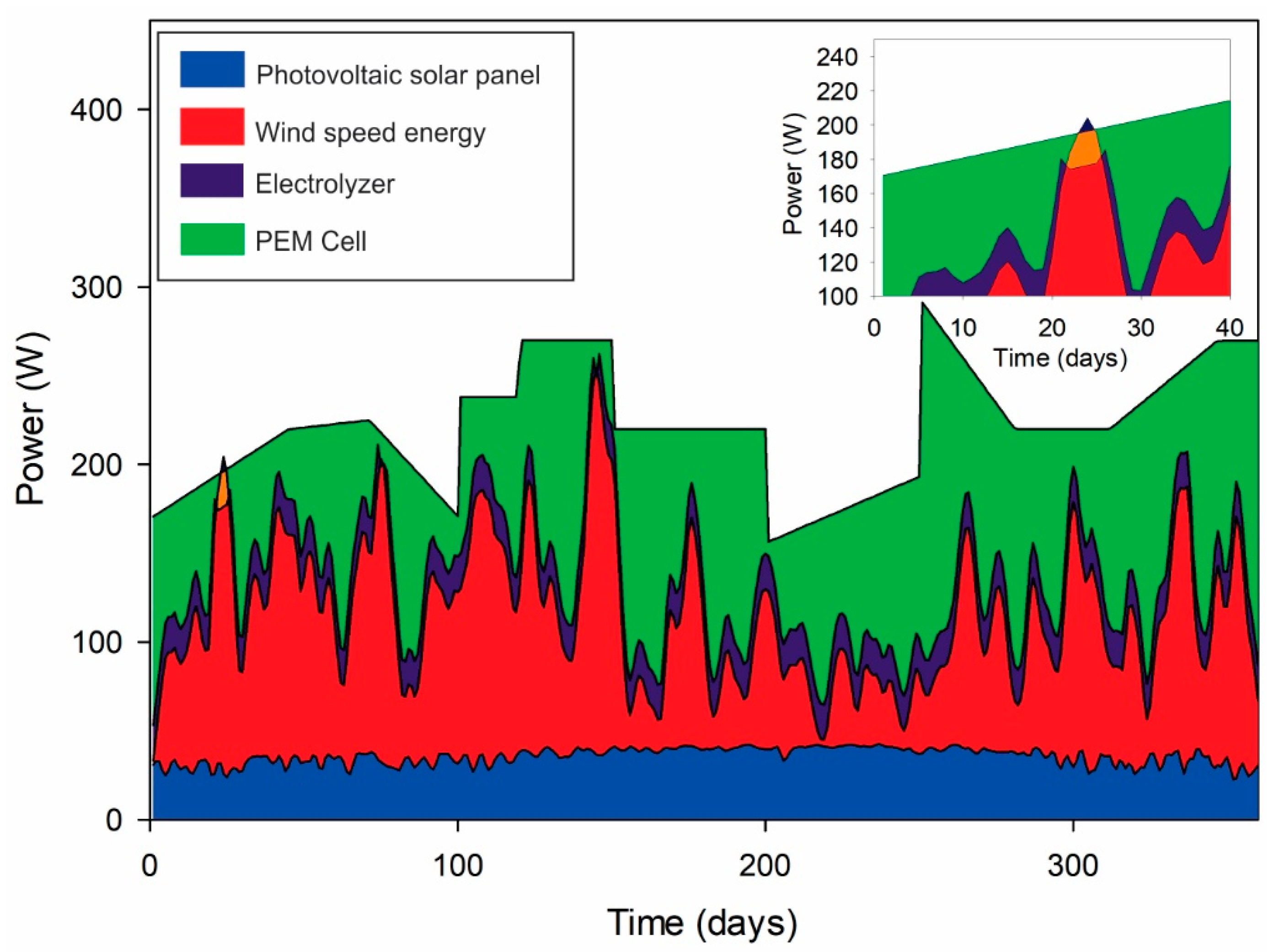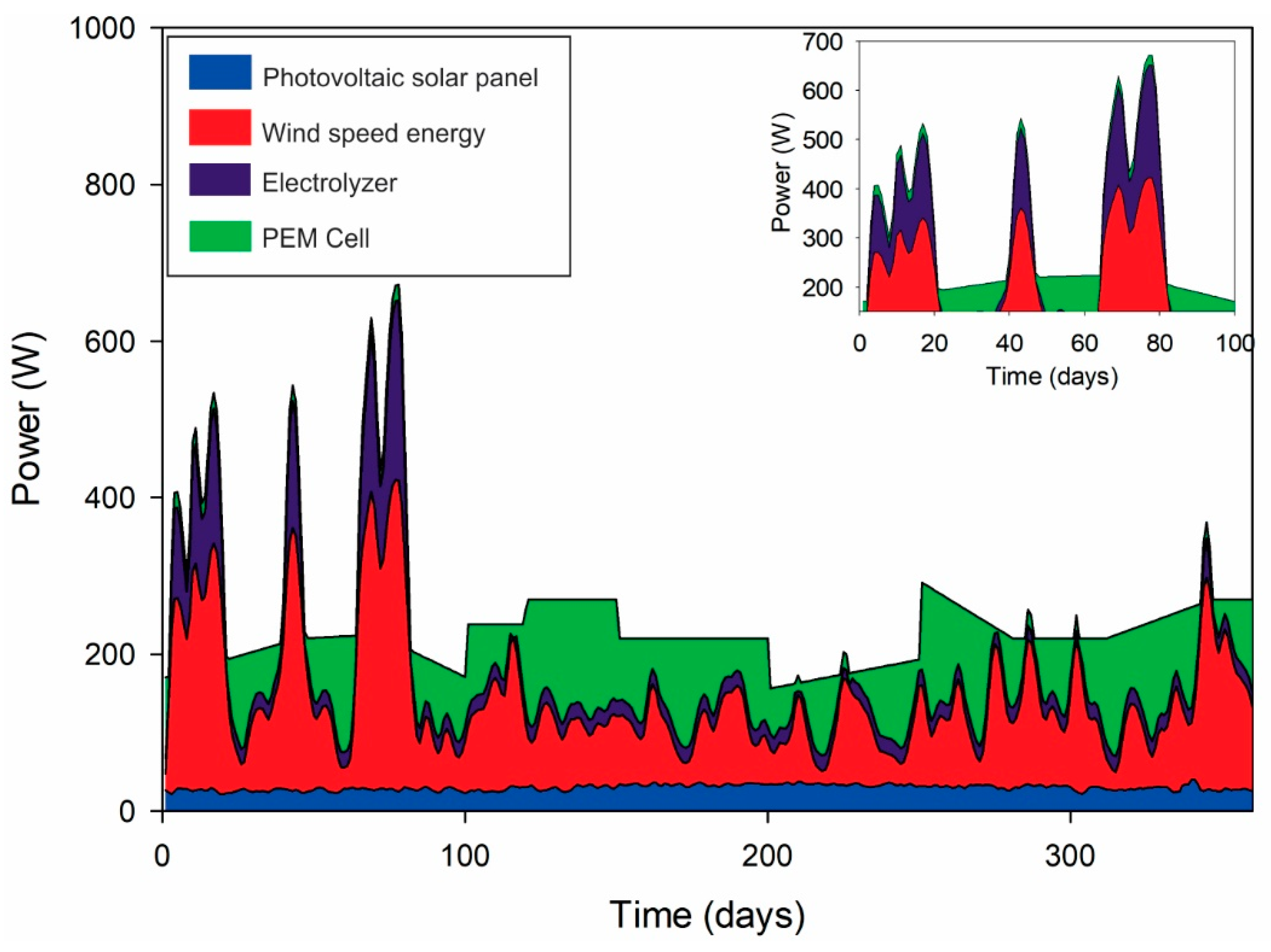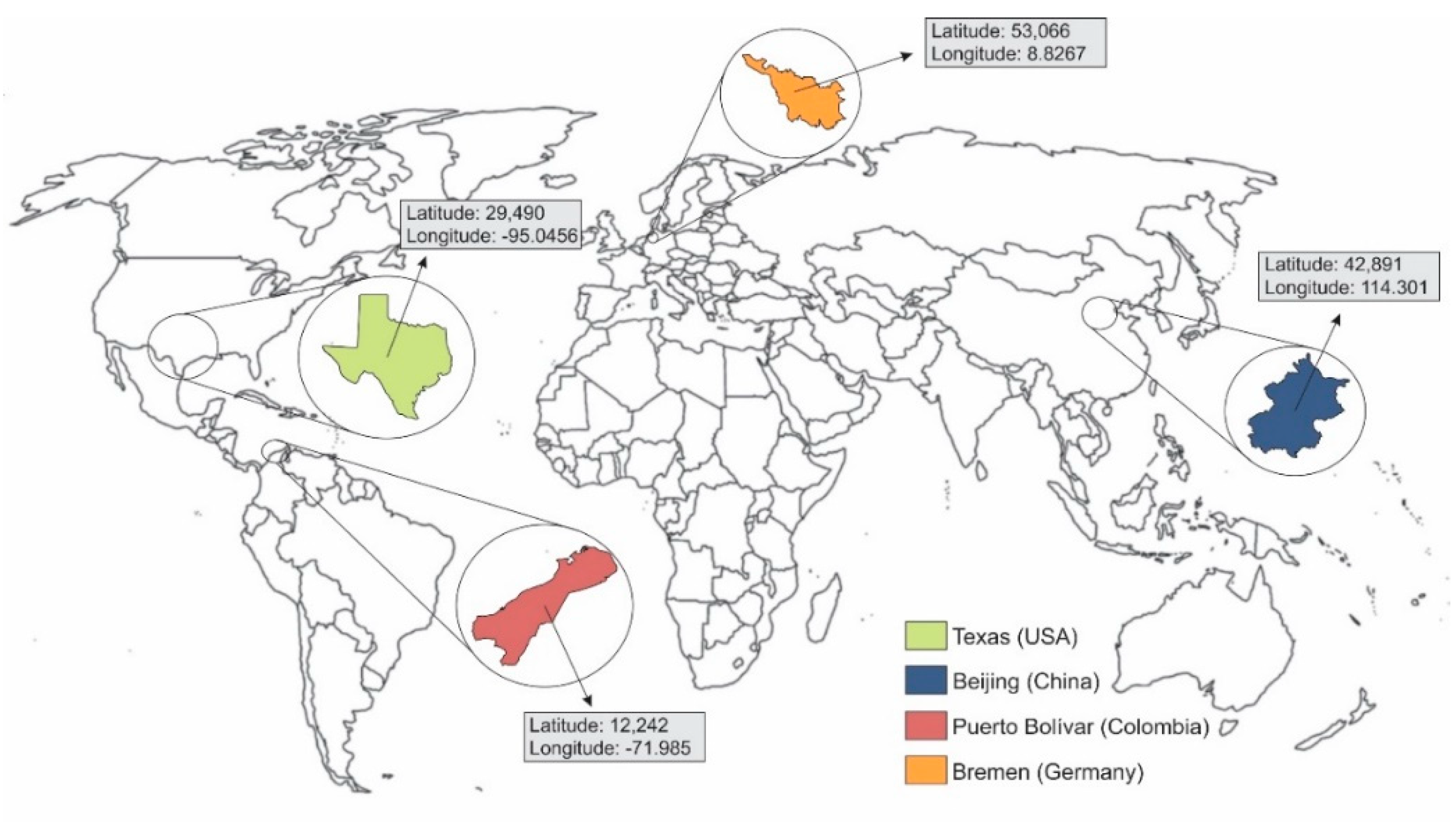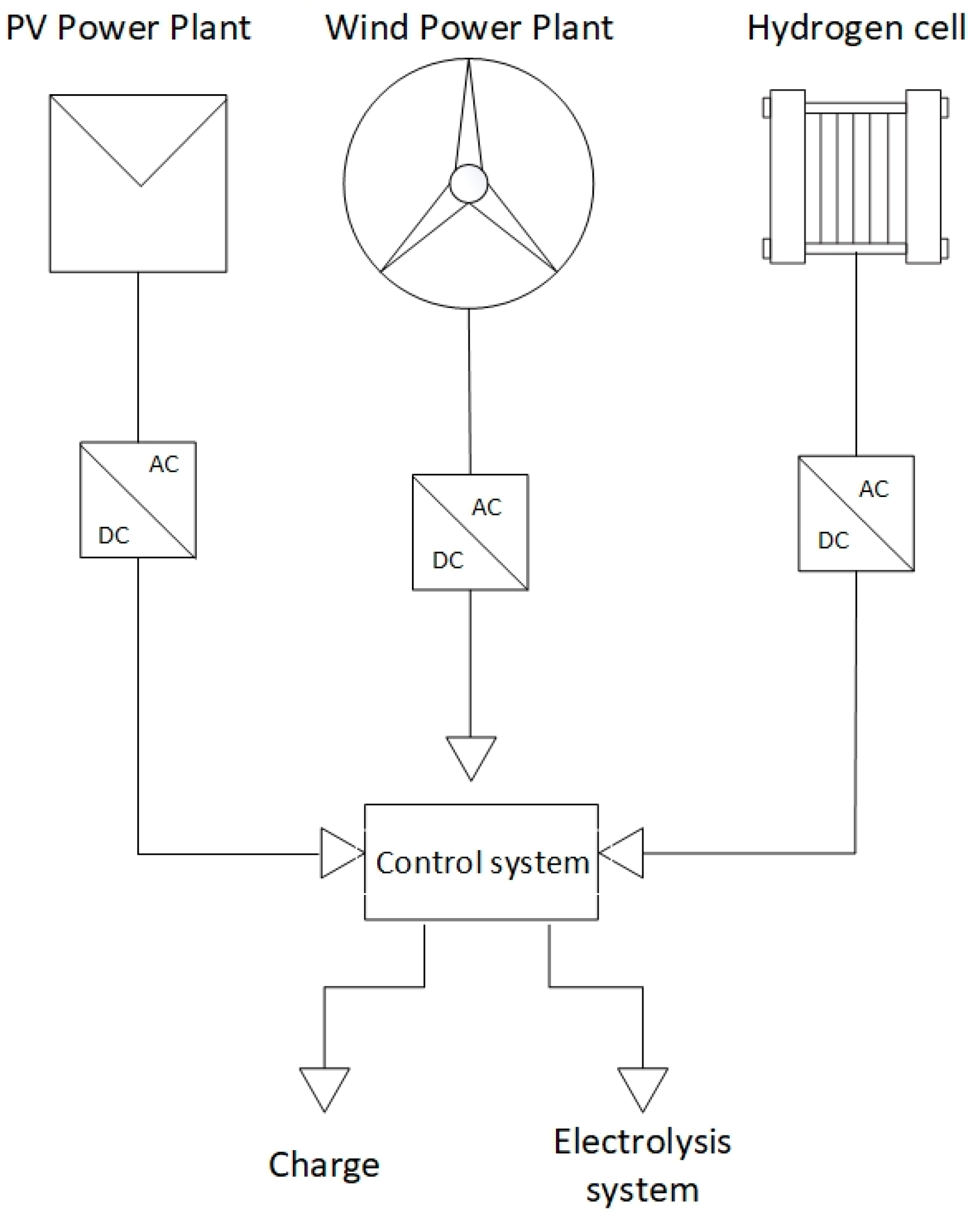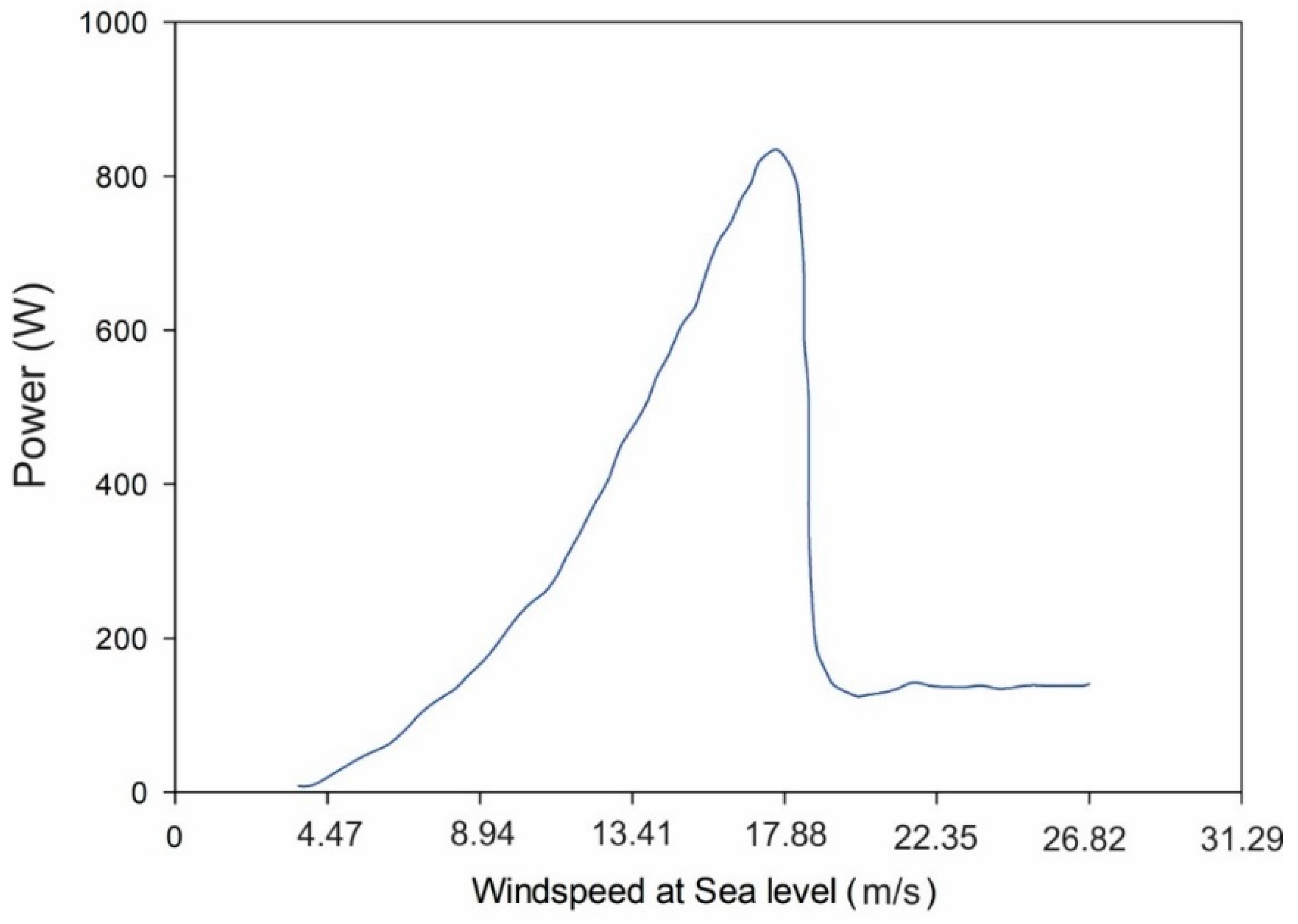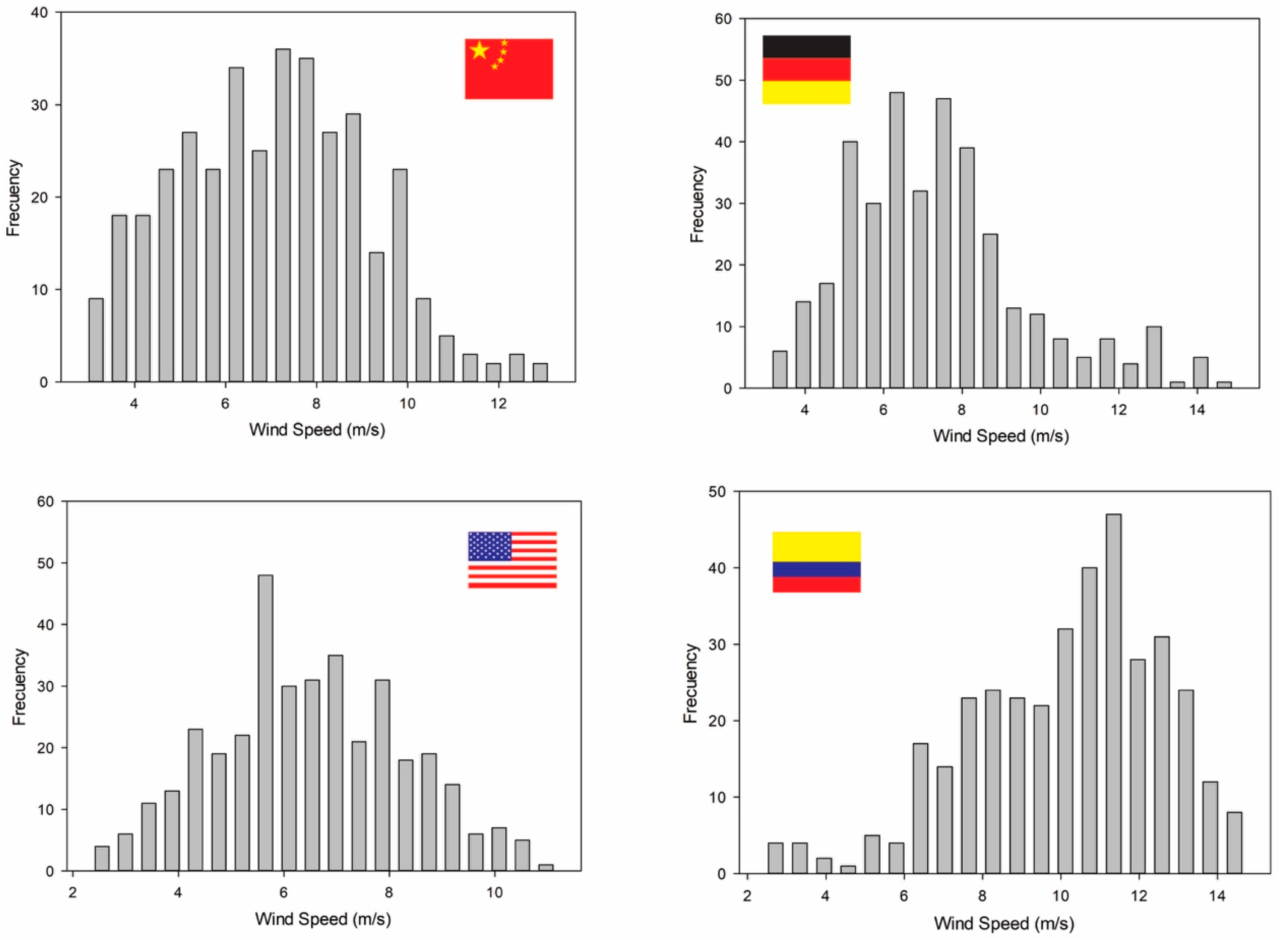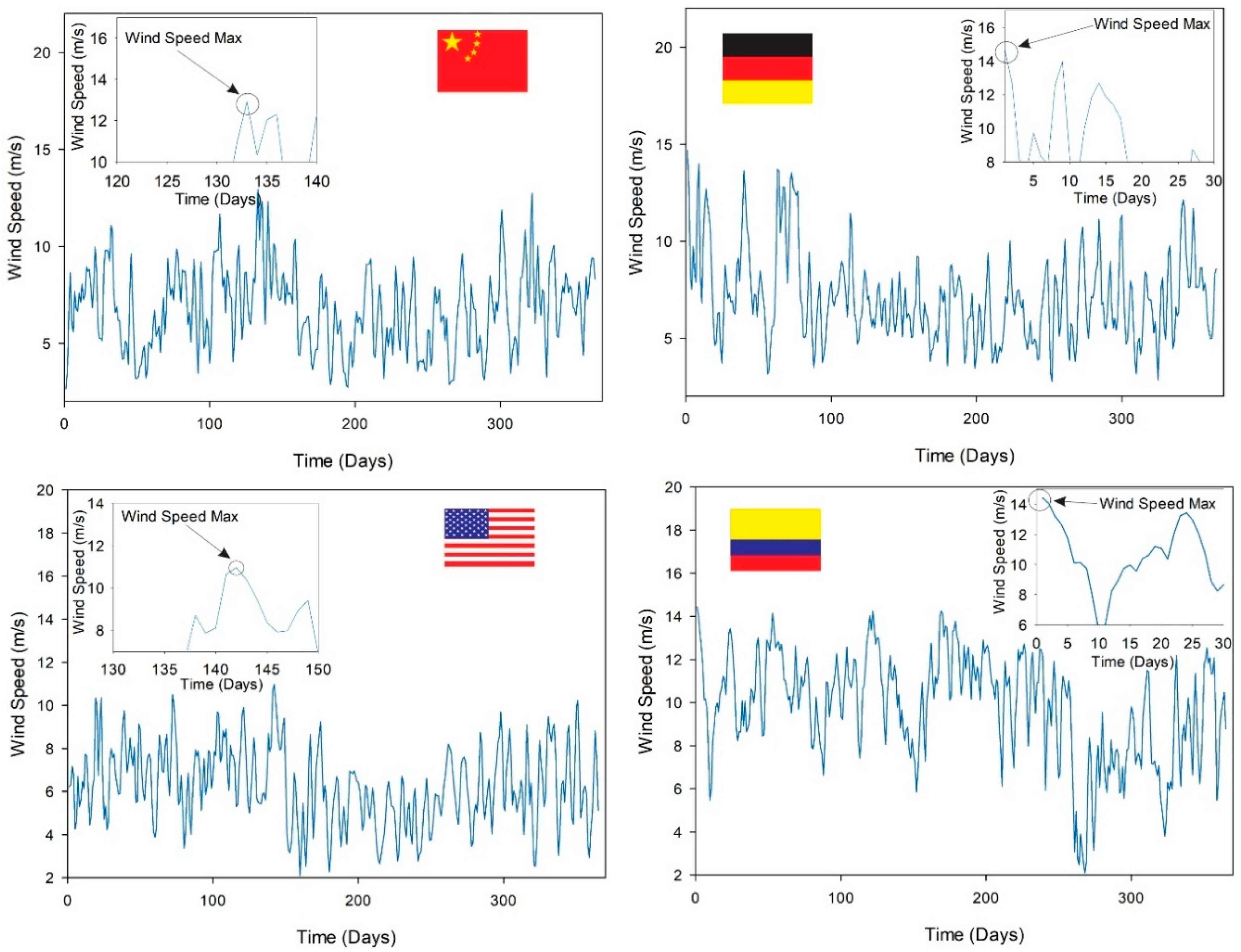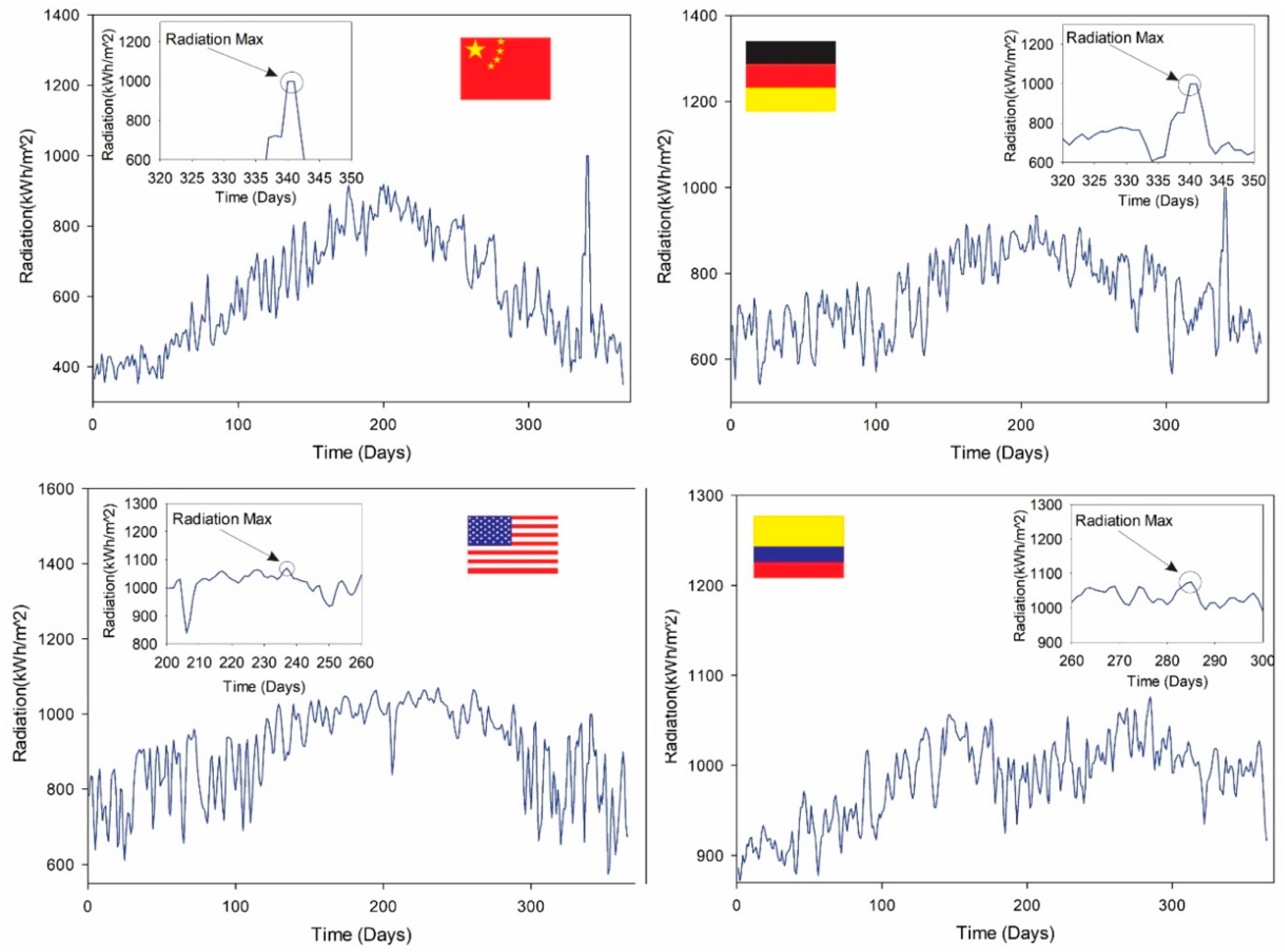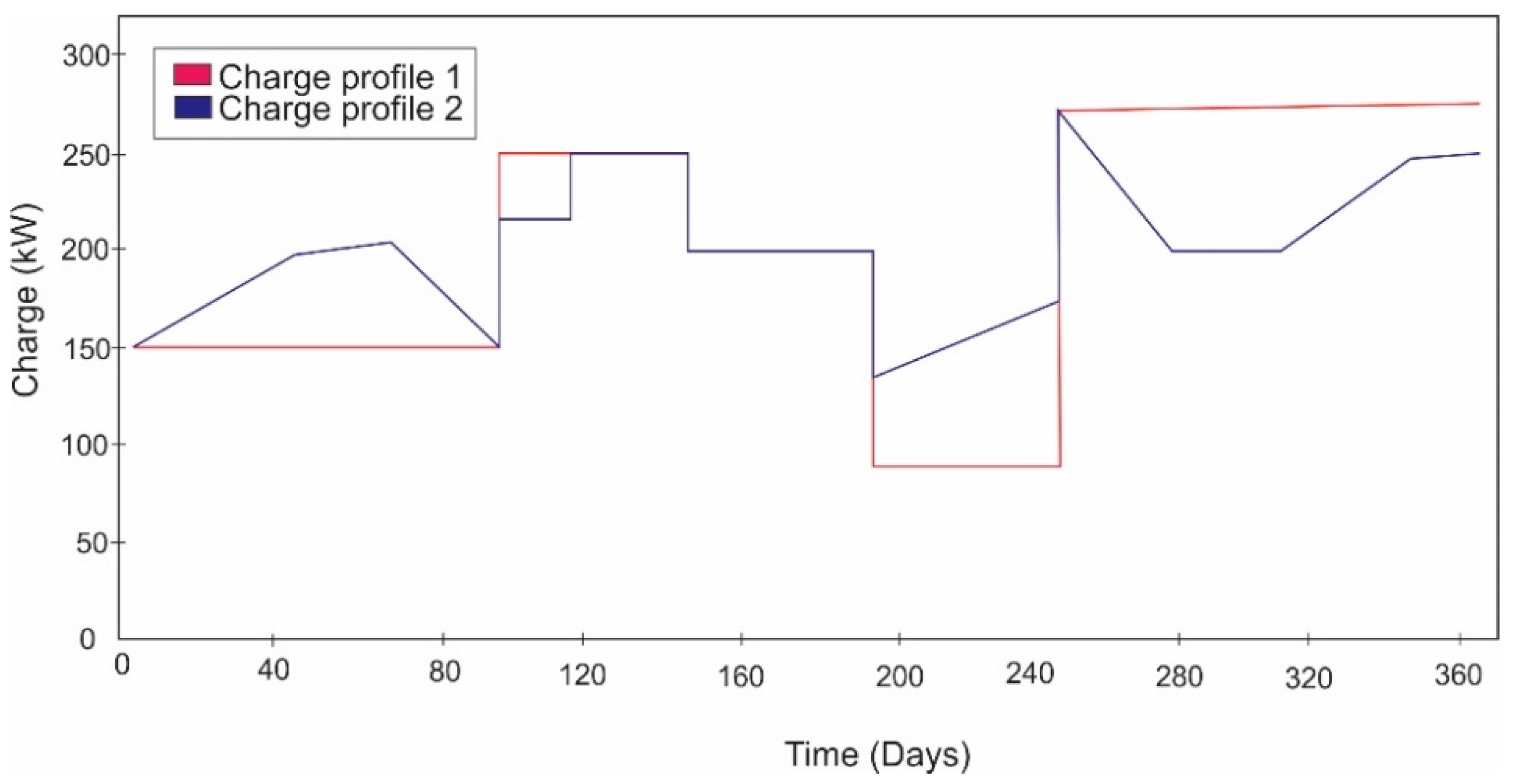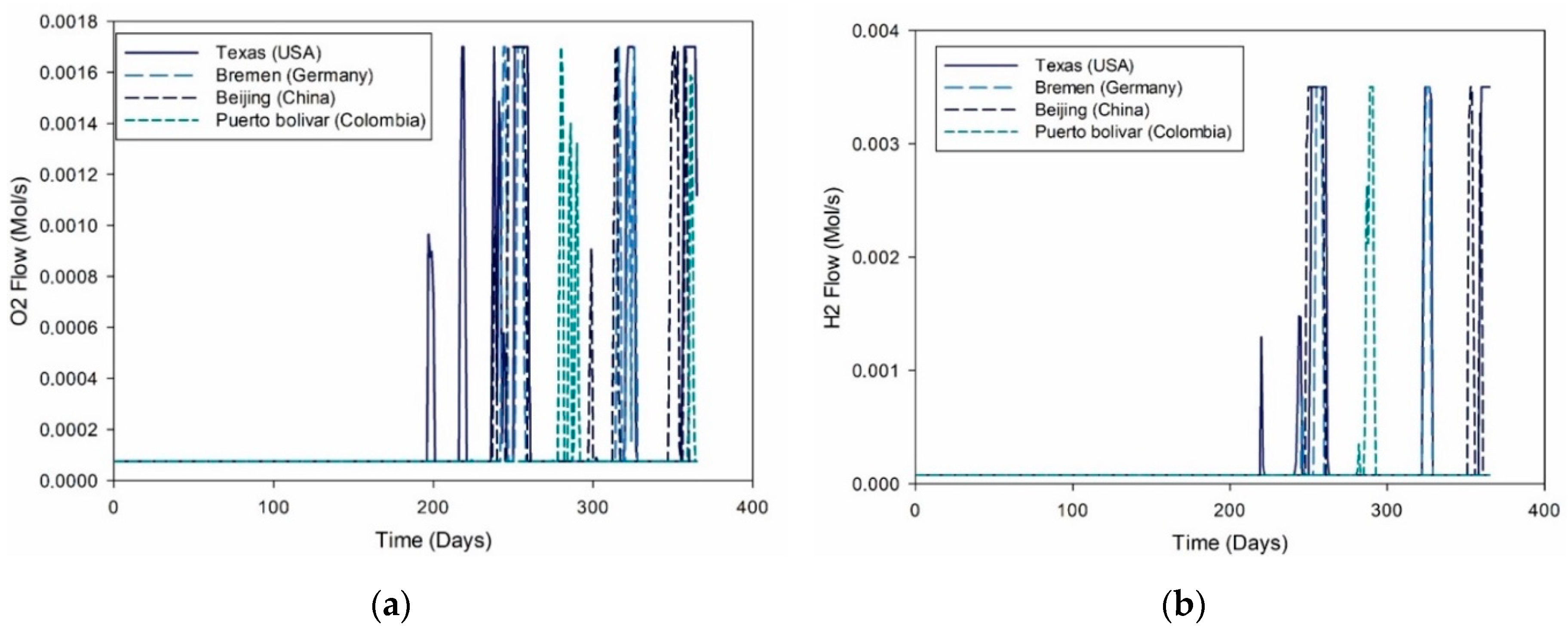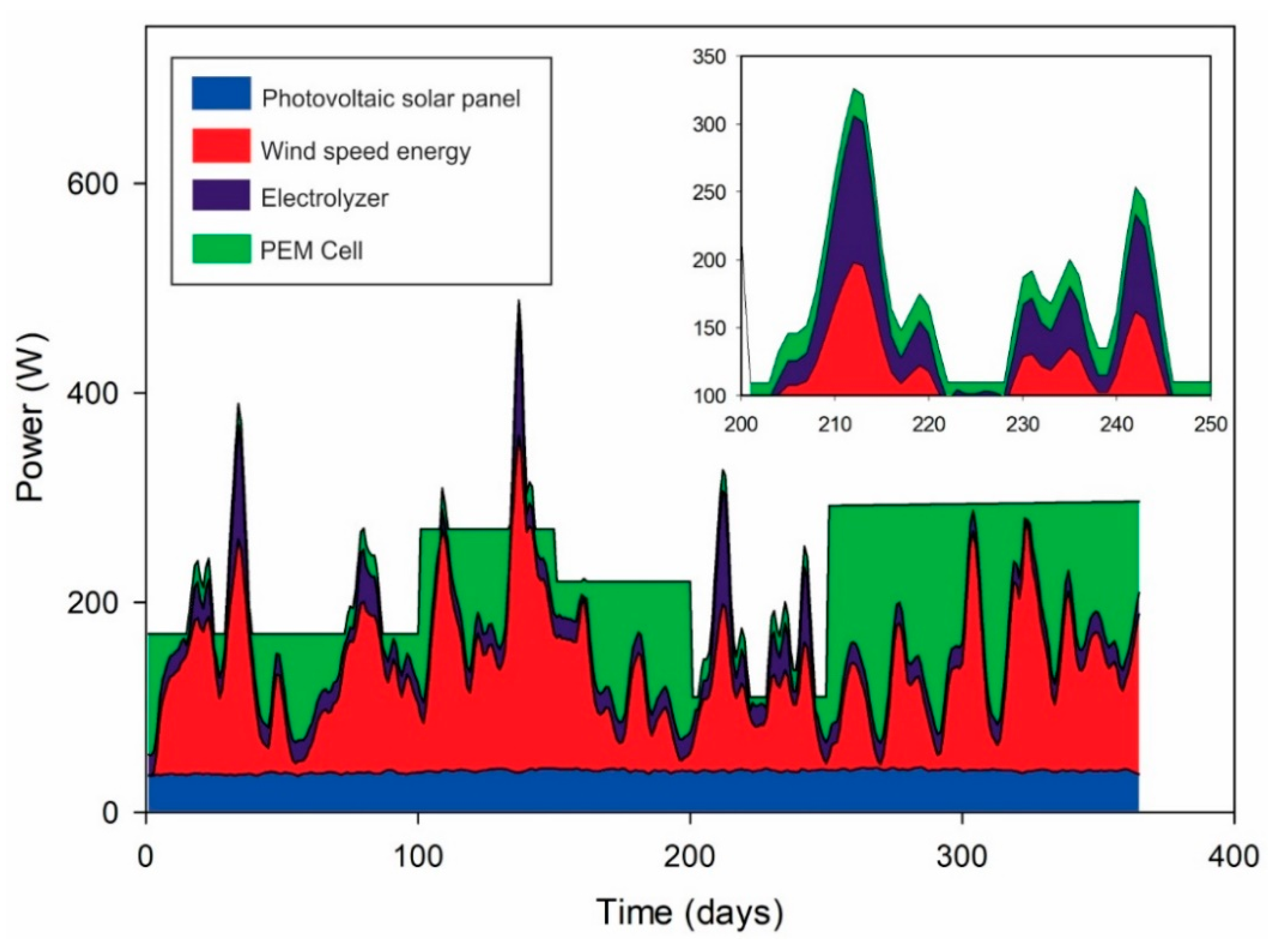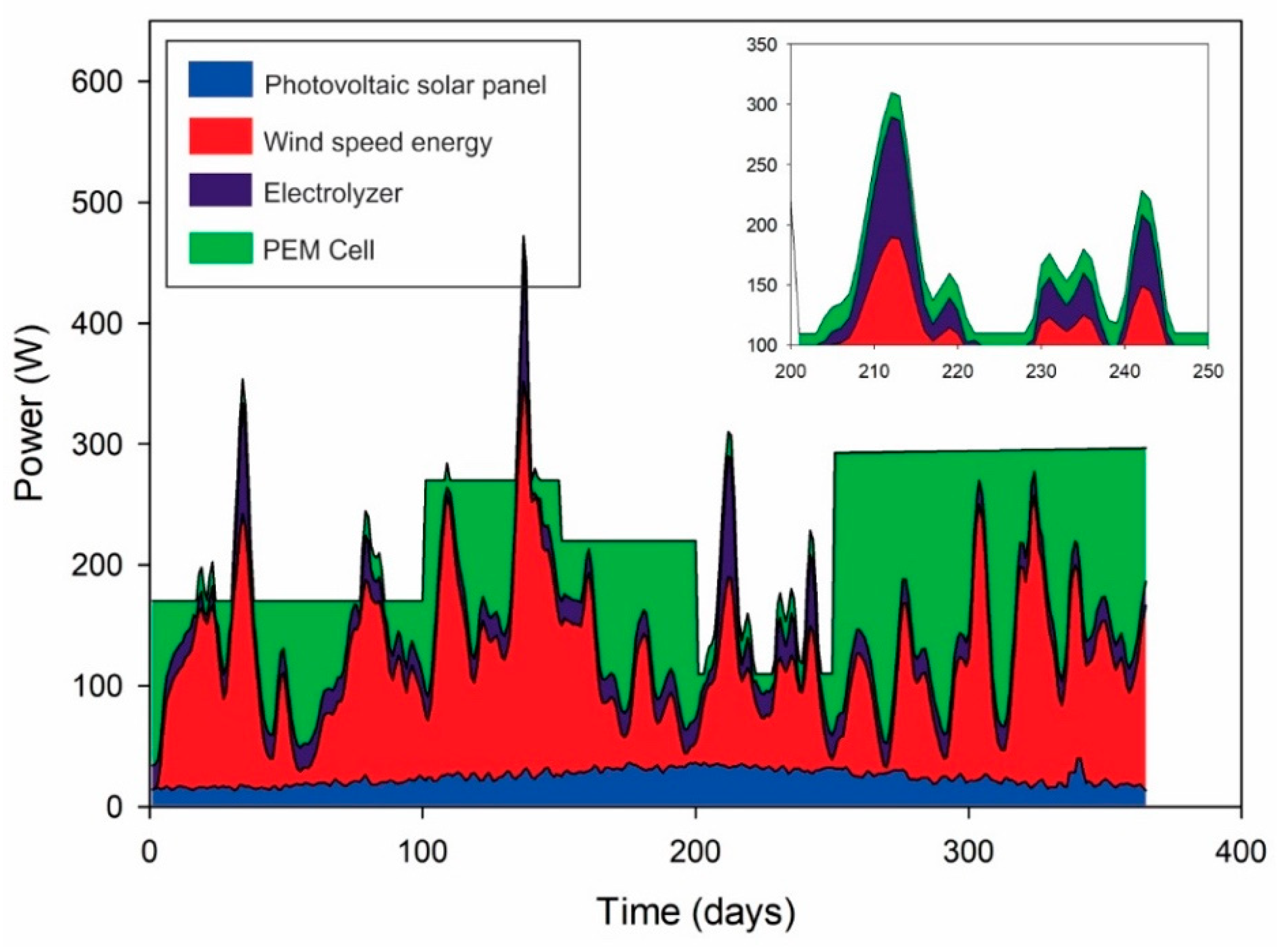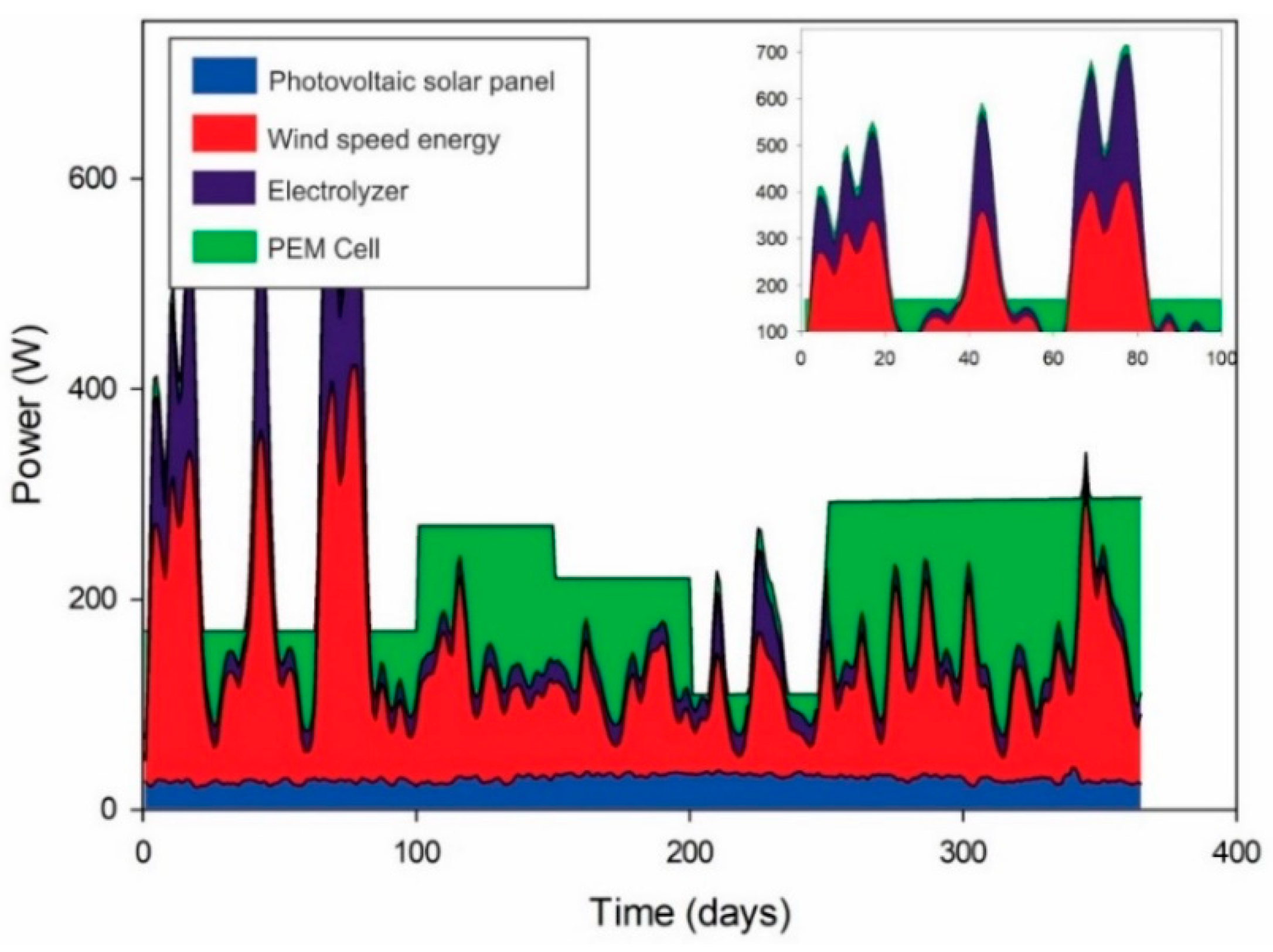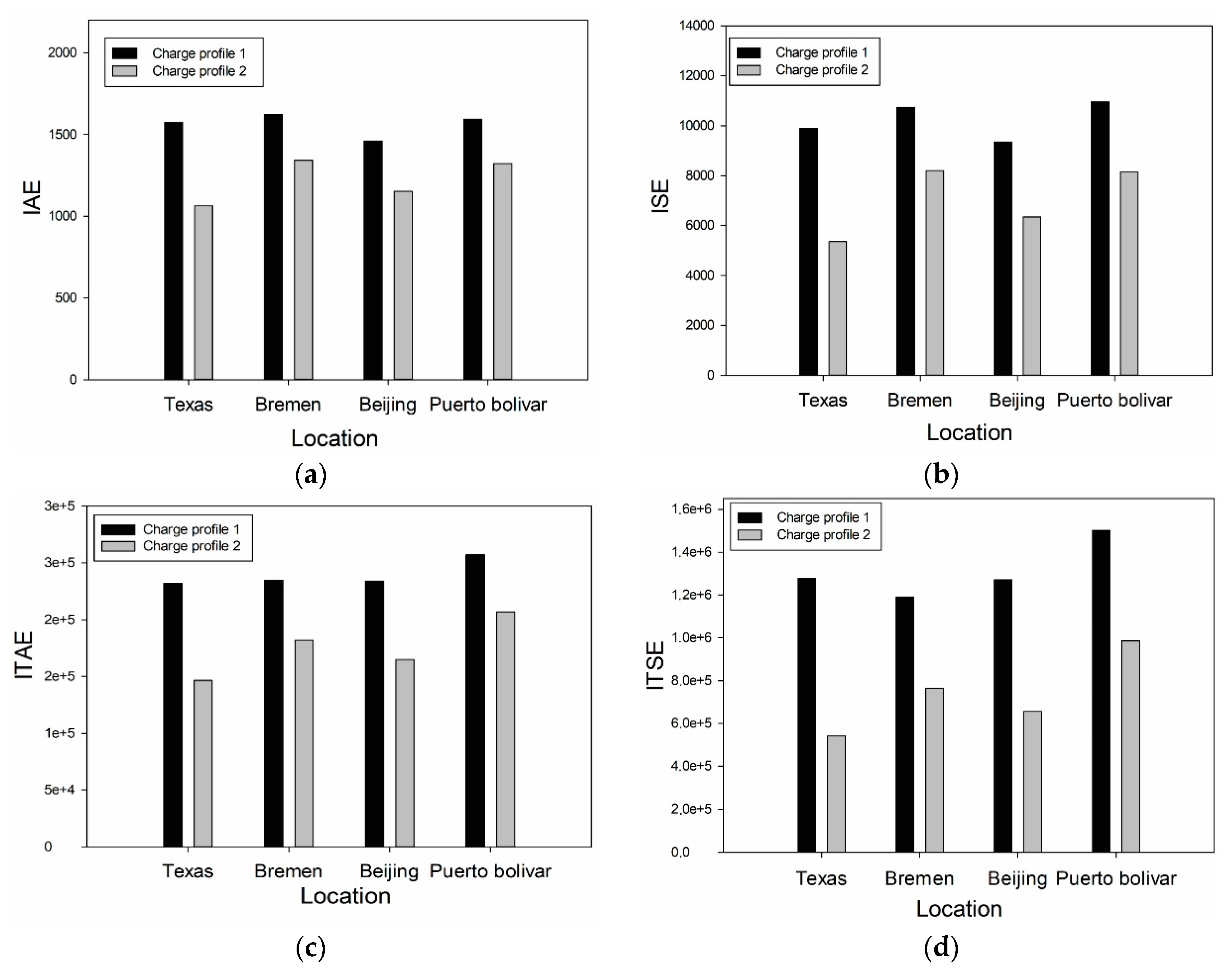1. Introduction
Global energy consumption has increased significantly due to population growth [
1]. The increase in energy demand has prompted the search for alternatives for energy generation, the development of thermal processes according to the rational use of energy, preservation of the environment [
2], and the improvement of thermal efficiency by mean of thermoeconomics modeling [
3] and thermoeconomic optimization [
4]. The development of new-generation systems using renewable energies has been one of the most widely studied options [
5,
6] because many countries have developed an energy policy that encourages the generation of environmentally friendly options based on clean-development mechanisms [
7]. Thus, the contribution of these energy sources globally has been growing. Between 2016 and 2017, as recorded by Bloomberg New Energy Finance (BNEF), there was an increase in renewable energy of 2%, which equates to a rise of almost 157 GW in global power generation [
8].
Electricity production from solar energy increased from 1050 GW in 1992 to 112,150 GW by 2013. Of this increase, 78% was produced by Japan, the United States, Germany, Spain, and Italy [
9]. This was achieved thanks to various projects that were developed in different countries. In South Korea, a neural network model was built to calculate horizontal solar irradiation, taking images from the Korean communication, ocean, and meteorological satellites (COMS) as input; this model has an error of 12% and a correlation coefficient of 0.975. The result of this model was the generation of hour-by-hour solar radiation maps in South Korea [
10]. Similarly, in Saudi Arabia, taking into account that this government wants to invest USD 109 billion over the next 20 years, a document was presented that assesses if there is potential for generating photovoltaic energy in homes. The results for two typical building structures in the country were analyzed, taking into account the demands for electricity of these buildings, and a cost–benefit assessment for different scenarios of photovoltaic systems was completed [
11].
On the other hand, wind energy has also been developed as a good alternative to fossil fuels for energy generation. This is reflected in research that shows that in the United States, there was an increase in the production of wind energy of approximately 14% between 2004 and 2013. Similarly, Germany and China presented increases in wind energy production, reaching approximate increases of 8% and 7.7%, respectively, for the same period [
12]. A recent study looked at the Changhua-South Offshore Wind Farm by using data obtained from a meteorological mast, a detection device, and a floating light range (LiDAR); these data were collected by the NASA Climate Simulation Center. The results of this assessment showed that at a height of 105 m, wind speeds were 7.97 and 8.02 m/s, from the floating LiDAR device and mast, respectively, and produced the potential of up to 314 GWh/year [
13]. Likewise, for Latin America, 141 locations in the Gulf of Mexico were analyzed by calculating the main characteristics of the wind. Hourly records from 1980 to 2017 were analyzed at a height of 50 m, using the free software R, and showed that different locations had different good wind seasons; for fall, winter, and spring, the states of Tamaulipas, Veracruz, and Tabasco were good for wind energy production, while Campeche and Yucatan were good in winter and spring [
14]. Despite this, low wind power has presented some difficulties for the development of wind energy production. This is mainly due to the low wind speeds and higher turbulence that occur in built environments due to the presence of obstructions. This turbulence causes fatigue in the turbines, which generates a decrease in their useful life, leading to an increase in maintenance costs [
15]. Similarly, it has been demonstrated that the use of low-scale, wind–solar systems represents a financial risk [
16].
Another alternative energy source is hydrogen, and this fuel has been the focus of studies in recent years. In the 2000s, research on this topic increased annually by 18% on average, and most of the papers presented were journal articles [
17]. However, one of the biggest challenges in using hydrogen as an energy source is the difficulty in storing it. For this reason, many works have focused on this problem. Between 2009 and 2018, 72.3% of all published literature on hydrogen cells focused on storage. In addition, the United States is the country with the most significant influence on hydrogen storage, even though China is the country that has published the most significant number of papers on this subject [
18]. Studies have also been carried out in which hybrid systems have been analyzed. These systems have been applied to electric vehicles, achieving an average consumption with a hydrogen cell of 3.7 kWh and 1.12 kg/100 km for hydrogen consumption [
19]. Similarly, hybrid systems made up of wind and solar generation, and the use of hydrogen cells have been evaluated. The authors of [
20] proposed a model that integrated a horizontal axis wind turbine and a solar panel system. PVC tubes were used as the material to construct the wind turbine blades. That work proposed the integration of two emerging energy systems based on non-conventional energy sources, through a load controller and an inverter for the energy supplied to the residential level [
20]. In addition, a smart energy hybrid generation system was studied, which integrated a fuel cell stack, a wind turbine, and a solar panel system. The results obtained in this study show that in the winter, the integration of the system with a wind source provides better performance than the solar system alone. The wind turbine produced 16 kW during January, while the solar system generated 2 kW during the same period. In June, the solar thermal system generated 17 kW, and the wind turbine only 11 kW, which means that the studies of these systems must be carried out for an entire year [
21].
The optimal design through optimization algorithms was studied for hybrid energy generation systems based on solar and wind sources, considering three search algorithms to improve the accuracy of the results. In that study, solar radiation was predicted from meteorological variables such as ambient temperature and wind speed with artificial neural network architecture. Thus, the size of the systems must be considered to determine the economic viability of these systems [
22].
These hybrid systems have presented promising results. The authors of [
23] created a system that has a solar heliostat field, a wind turbine, and a copper-chlorine thermochemical cycle for hydrogen production. In this system, the solar heliostat field was used as a thermal energy source, and the wind system was used to generate the electrical energy necessary for electrolysis and the compressors of the hydrogen storage system. This system was modeled and simulated, obtaining high hydrogen production rates and an overall system efficiency of up to 49% [
23].
The main contribution of this paper is to present the comparative performance analysis of hybrid renewable energy generation systems under different load demands, located in areas with the greatest wind and solar potential in Colombia. In addition, meteorological data to calculate mathematical models were used to predict the solar radiation and statistical probability methods for the wind speed prediction in the selected areas. Simulating the system is expected to test the operational planning, the renewable energy complementarity of this system in the selected areas, and the feasibility of using the proton exchange membrane (PEM) cell as a support to the hybrid renewable system at those times of the year when wind and solar valleys are present. Likewise, some performance indicators of the proportional integral derivative (PID) control system based on the error calculation are evaluated under two energy demand profiles. The evaluated performance indicators include the absolute value of the error (IAE), the integral of the square of the error (ISE), the integral of the absolute value of the error for time (ITAE), and the integral of the square of the error for time (ITSE).
3. Results and Discussions
Based on the dynamic conditions established for the different places of interest by the control system, an evaluation of the behavior of the molar flows of
and
was carried out to identify the energy contribution of the PEM cell. The PEM cell complemented the energy generation provided by the wind turbine and the solar cell, achieving with these three, the dynamic load required by the system. The PID control system regulated this molar flow. This regulation resulted in the behavior presented in
Figure 8. For the case of
flow observed in
Figure 8a, the molar flow was maintained at its minimum value to keep the PEM cell in operation without making energy contributions to the hybrid generation system in the four locations studied. On 19th October (day 292 of the year), the
flow in Texas increased from
mol/s to
mol/s; this same increase was presented on 21 October (day 294 of the year) and 12 October (day 285 of the year) for Bremen and Beijing, respectively. As for Puerto Bolivar, the increase in the flow reached the value of
mol/s on 11 November.
Similarly, for the flow of
presented in
Figure 8b, the molar flow was kept at its minimum value to keep the PEM cell in operation without providing energy to the hybrid generation system in the four locations studied. The increment of the molar flow of
for 22 October went from
mol/s to
for Texas. Similarly, for Bremen, it went from
mol/s to
mol/s on 23 October, and from
mol/s to
mol/s on 14 October for Beijing. In the case of Puerto Bolivar, on 29 November there was an increase from
mol/s to
mol/s. The days indicated with an increment for
and
are the first days on which the PEM cell contributed to the generation to achieve the required load.
Two of the limitations to the proposed control system for the hybrid system based on non-conventional energy sources were to model the components of the system and to know the meteorological variables that allow for prediction of the energy generation of the system. Thus, Song-Yul Choe [
41] performed dynamic modeling of a PEM-type fuel cell, where the load demand, fuel flow, and temperature play an important role when applying a control system. The dynamics and performance of the designed controllers were evaluated and analyzed by simulations using dynamic fuel cell system models, similar to the one proposed in the current study, using a multistep current and an actual load profile.
Likewise, Granda-Gutiérrez et al. [
42] presented a model of a fuel cell integrated to a solar panel array and studied the effect of solar irradiation and solar cells on the voltage, current, and power of the fuel cell. One of the main limitations of that work, compared to the results presented in the current article, is that the system considers the wind resource in the hybrid system, and it also allows for the study of the time evolution of the complementarity of the energies and the performance of the control system to satisfy the energy demand.
For the case of load profile 2,
Figure 9 illustrates the molar flow behavior of
and
.
Figure 9a shows the variation of
flow required for the PEM cell. Initially, for the four locations, the flow presented is the minimum to keep the PEM cell working, and from 10th July, the
flow for Texas showed an increase from
mol/s to
mol/s. Similarly, on 31 August and 4 September there was a change compared to the minimum flow value of
in Bremen and Beijing, respectively; it went from
mol/s to
mol/s for Bremen and from
mol/s to
mol/s for Beijing. In the case of Puerto Bolivar, the increase of the minimum molar flow value of
occurred on 7 October and went from
mol/s to
mol/s.
As for the flow of
, in
Figure 9b it can be seen that for the case of Texas, on day 220 the first increase in molar flow was presented, going from
mol/s a
mol/s. In the case of Bremen and Beijing, the first increases occurred on 3 September and 6 September, respectively; going from
mol/s to
mol/s for the Bremen and from
mol/s to
mol/s for Beijing. On the other hand, in Puerto Bolivar, this increase in molar flow did not occur until 8 October, from
mol/s a
mol/s.
The variations in the intensities of solar radiation and wind speed that motivate these variations in the molar flows of
and
change the amount of power generated by each of the sources. These combinations are variable for each of the geographical areas analyzed, as well as for each load profile. These powers were analyzed for each of the areas studied.
Figure 10 shows the power generated by the system for Puerto Bolivar (Colombia) for the demanded load profile 1.
Figure 10 highlights what happened between 19 July and 7 September, days on which the generated power exceeded the power demand stipulated in the load profile. This was due to above-average winds and a slight increase in average solar radiation added to the low demand at this time of year, which led to the observed overshoot.
Similarly,
Figure 11 shows the power generated by the system in Beijing (China) for load profile 1. As in the previous case, increases in solar radiation and wind speed and a decrease in load demand coincide. This point is relevant due to the fact that the excess in the demanded charge was maintained from 19 July to 7 September, unlike the cases that occured on the previous days, which were only daily peaks in wind speed. This figure also shows the influence of the solar radiation peak highlighted in
Figure 6; this increase in radiation occurred at the time of year when the load demand for the simulation was higher, so the system needed the PEM fuel cell operation to achieve the load demand. However, the tunning parameters of the control system are responsible for ensuring that the hybrid system follows the energy demand, regardless of the wind or solar resource peaks.
Likewise,
Figure 12 shows the power generated by the system in Texas (USA) for load profile 1.
Figure 11 highlights the last days of January, together with the month of February, in which there was an increase in wind speed, causing a generated power higher than the demanded load profile. The rest of the time, the generation contributed by the solar radiation and the wind was complemented with the contribution of the PEM cell; this contribution is evident in the increase of the flows of
and
presented in
Figure 8a,b.
In the case of Bremen (Germany), the results are presented in
Figure 13. In
Figure 13 it can be seen that in the first 100 days of the year, there were peaks in wind speed, which triggered an increase in the energy generated that exceeded the load profile. This increase was the highest presented in the four locations analyzed and is due to the increase in wind speed presented on those days, which, as in the previous peaks, generated a high activity in the electrolyzer observed in the purple area. Similarly,
Figure 13 shows that the contribution of solar energy made at the peak of solar radiation highlighted in
Figure 6 is not as high as the contribution made by the wind speed when it reached more than 10 m/s in the following days.
These generation peaks occur due to increased wind and solar radiation causing an overshoot of the load demanded by the profile. In
Table 6, a sum of the total energy generated monthly by the solar panel, the wind turbine, and the PEM cell for load profile 1 is presented. In addition, a comparison is made with the load demanded for the same period in each of the areas studied. This comparison allows us to observe that Bremen is the location with the highest excess energy generated due to the peaks of wind speed and solar radiation in the whole simulated period, reaching 9801 W, well above the 1389 W in Texas, equivalent to 14% of the excess energy generated in Bremen. Likewise, 3549 W was generated in excess in Beijing to reach 36% of what was generated in Bremen. Finally, in Puerto Bolivar, 4828 W was generated, reaching 49% of what was generated in Bremen. In spite of this, Bremen is the location with the second-highest number of months with a generation equal to the demand due to the load profile reaching 5 months, only surpassed by Texas that reached 6 months without excess generation, which shows that the high wind and solar activity presented in the first 3 months was decisive to achieve the 9801 W of excess generation in Bremen.
On the other hand,
Table 7 presents for load profile 2 the total sum of the energy generated monthly for each of the actors in the hybrid generation system. It shows Bremen as the location with the greatest excess of energy generated, reaching 7071 W, quite far from the excess generated in Texas, which only reached 204 W, meaning only 3.41% of the excess generated in Bremen. Likewise, in Beijing, 1600 W of excess energy was generated, representing 22% of the excess generated in Bremen. On the other hand, Puerto Bolivar was the closest location to Bremen, with an excess generation of 2646 W, being 37% of what Bremen generated. Besides this, Puerto Bolivar was the location that presented an excess of generation in more months, with 10 months exceeding the demand presented by the load profile 2. Only in September and December was this demand not exceeded. The opposite was the case with Texas, where the demand for the profile was exceeded in only three months and the PEM cell had to cover the demand imposed by the load profile.
For the evaluation of the performance of the controllers, the four indices selected for this evaluation are presented in
Figure 14. For each of these indexes, the stabilization times were calculated, and the sum of all these times during the simulation year was plotted, obtaining two indicator values for each location studied.
Figure 14a shows the IAE values for load profile 1 in black and for load profile 2 in gray; it can be seen that the stabilization time for load profile 2 is approximately 21% less on average, with the smallest time difference in Puerto Bolivar, presenting 17% less time for the second load profile.
Figure 14b shows that the trend presented in the IAE is maintained in the ISE. In this indication, the stabilization time is more significant for load profile 1, and on average, the time for load profile 2 is approximately 31% less, reaching the most considerable difference in Texas where the stabilization time for the second load profile is 45% less. This significant difference in stabilization time occurs for two main reasons. The first is the difference in the load profiles; the changes in the load are smoother than in the second load profile than they are in the first. The second reason for this shorter stabilization time is that the power generated by the system in Texas for the second load profile almost never exceeds the demanded load, which allows reaching the setpoint more easily.
On the other hand, in
Figure 14c the ITAE indicator is shown, in which it can be observed that, as in the two previous cases, the second load profile generates a time of stabilization less than the first, due to the smooth variation in the load demanded from the system. In this indicator, the load profile is 27% less on average for the four locations, pointing to Puerto Bolivar as the location that presented a smaller difference than the others, reaching a 19% difference between the profiles. This is due to the constant surpassing of the demanded load profile, caused by the constant increases in wind speed in this area.
Finally,
Figure 14d shows, for the ITSE indicator, the most significant difference in stabilization time between the two load profiles. On average, the time for the second load profile is 44% less than the time required by the control system to achieve stabilization for the first profile. In this indicator, the difference in stabilization time between the two profiles presented in Texas is 57%. This difference is due to the fact that solar and wind power generation was always below the load profile.
The results presented in this article were developed from a dynamic hybrid system model similar to the one proposed by M.T. Iqba et al. [
29], who presented the simulation of a photovoltaic component system, considering only a Southwest Wind Power Inc. AIR 403 wind turbine, a PEM fuel cell, and an electrolyzer. The dynamic model was evaluated in Simulink, and the transient responses of the system under a step change of the power load and wind speed were studied, regulating the system with a classical PID control system. In addition, G. E. Valencia et al. [
43] tested the hybrid system model without a solar photovoltaic source and improved the energy performance using the generalized predictive control system, also simulated in MATLAB/Simulink software, which is a widely software used to simulate model of energy generation systems [
44]. However, the application of this hybrid system guarantees the maximum use of the renewable energy resources available in the places selected in this study, since they are places with high solar radiation.
4. Conclusions
When reviewing the wind and solar behavior of the four selected locations, it was concluded that the level of solar radiation presented by Puerto Bolivar was higher than that presented by Texas, Beijing, and Bremen. Only Texas presented a similar behavior due to the fact that both regions are desert zones. As for the wind speed, the behavior presented was much more variable, with each region presenting its peak at different times of the year. The highest peaks occurred in the first three months of the year in all four locations.
Similarly, the simulation allowed us to conclude that the implementation of a PEM cell as a support to wind and solar generation system was very effective in meeting variable energy demand. The PEM cell, together with a PID system, was able to deliver the necessary energy in spite of the fact that in some seasons of the year, the climatic conditions to cover the demand were not available, as was observed in Texas for the load profile 2. This control system was strongly affected by the high peaks in the input variables over time. This can be appreciated in the first three months of the year in Bremen. The high wind supply made it difficult for the hybrid trigeneration system to maintain a stable power output by increasing the settling time, which could cause problems by exceeding the demanded load.
In addition, the evaluation of the performance of the controller through the indicators IAE, ISE, ITAE, and ITSE, showed that the PID used presented a shorter error stabilization time when the changes in the load were smoother, and the error was given by radiation levels, and wind speeds lower than necessary, forcing the PID to vary the molar flow of and .
The results allow us to conclude that the difficulty of controlling a multivariable process such as a hybrid generation system is not limited only in the number of variables, but also by the interaction that exists between the subsystems (wind turbine, fuel cell, and solar photovoltaic system). The degree of interaction will determine whether the control strategy to control the process should be decentralized or centralized. Therefore, it is necessary to have interaction measures to help make such a decision, as is the case of the relative gain matrix, which is a heuristic technique without a strong theoretical basis, but rigorous connections have been established between the relative gain matrices and the stability for systems from their transfer functions. Thus, a relative gain matrix is proposed to advance in the study of the stability of multivariable control systems of hybrid energy generation processes.
In the ITSE, it was observed that the second load profile in the study generated a lower stabilization time than the first one, due to the smooth variation in the load demanded from the system. In this indicator, the load profile was 27% lower on average for the four locations, with Puerto Bolivar standing out as the location that presented the smallest difference from the others, reaching a 19% difference between the profiles due to the variability in the study period for wind and solar resources.
